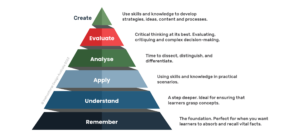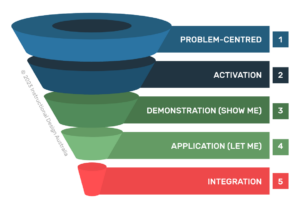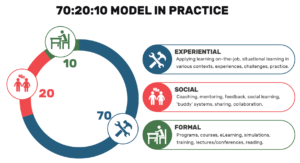Designing Success: The Role of Learning Architectures in Modern L&D
Ever wondered how top organisations consistently deliver knockout training programs? The secret ingredient isn’t just great content or fancy tech – it’s the invisible scaffolding that holds it all together. Enter the world of learning architectures, the unsung heroes of effective corporate training.
What is a learning architecture, anyway?
Think of it as the DNA of your training program. It’s the master plan that outlines:
- What learners need to know
- How they’ll learn it
- When each piece of the puzzle fits in
- How success will be measured
Learning architectures are comprehensive blueprints for educational success. They combine various elements (teaching methods, evaluations, real-world applications) into a cohesive, fulfilling, and enriching learning experience that leaves participants feeling accomplished, capable, and changed.
Example 1
Example 2
Learning architectures: Why should you care?
- No more training spaghetti: Without an architecture, you’re throwing training at the wall and hoping it sticks. With one, you’ve got a clear game plan.
- Speak stakeholder language: Want to get buy-in from the C-suite? A well-crafted learning architecture translates your training vision into business impact they can understand.
- Learner motivation boost: When learners can see the big picture of their development journey, they’re more likely to stay engaged and committed.
- Resource optimisation: Know exactly what you need, when you need it. No more last-minute scrambles for subject matter experts or materials.
- Measurable impact: With clear checkpoints built in, you can track progress and prove the value of your training initiatives.
How we build learning architectures
- Deep dive discovery: We don’t just skim the surface. We dive deep into your organisation’s culture, challenges, and goals.
- Outcome-driven: Every piece of the architecture is laser-focused on achieving specific, measurable learning outcomes.
- Mix it up: We blend different learning strategies and modalities – eLearning, workshops, on-the-job practice – to keep things fresh and effective.
- Build in learning checks: Regular assessments and feedback loops ensure learners are on track and the program is delivering results.
- Stakeholder harmony: We bring all the key players together to ensure the architecture hits the right notes for everyone.
From blueprint to reality
Once we’ve got the architecture nailed down, we don’t stop there. We use it as a launchpad to:
- Design detailed learning experiences
- Develop engaging content
- Create assessment tools that actually measure what matters
- Produce materials that bring the vision to life
The learning architecture is the backbone of our entire program design process. It’s like the blueprint of a house – without it, you’re just throwing bricks around and hoping they stick.
Why learning architectures matter
“But we’ve always done it this way!” Sound familiar? Here’s the truth – in today’s fast-paced business world, the old way of throwing together training programs just doesn’t cut it anymore. Learning architectures aren’t just a fancy buzzword – they’re the difference between training that ticks a box and training that transforms your organisation.
The bottom line
Learning architectures are the secret weapon of L&D professionals who are serious about making an impact. They’re not just pretty diagrams – they’re strategic tools that ensure your training programs are thoughtfully designed, well-structured, and laser-focused on driving real results.
So, next time you’re tasked with developing a training program, don’t just dive in. Take a step back, grab your metaphorical hardhat, and start architecting. Your learners (and your organisation’s bottom line) will thank you.
Ready to start building? Let’s chat about how we can help you create learning architectures that turn your training vision into reality.
Related articles



Bloom’s Taxonomy: A Guide for Creating Effective Learning Outcomes
Merrill’s Instructional Design Principles
The 70:20:10 Learning Model
